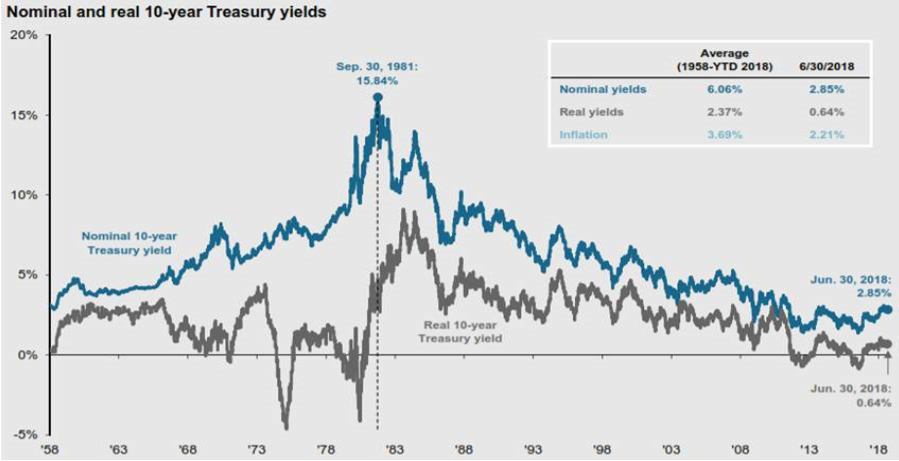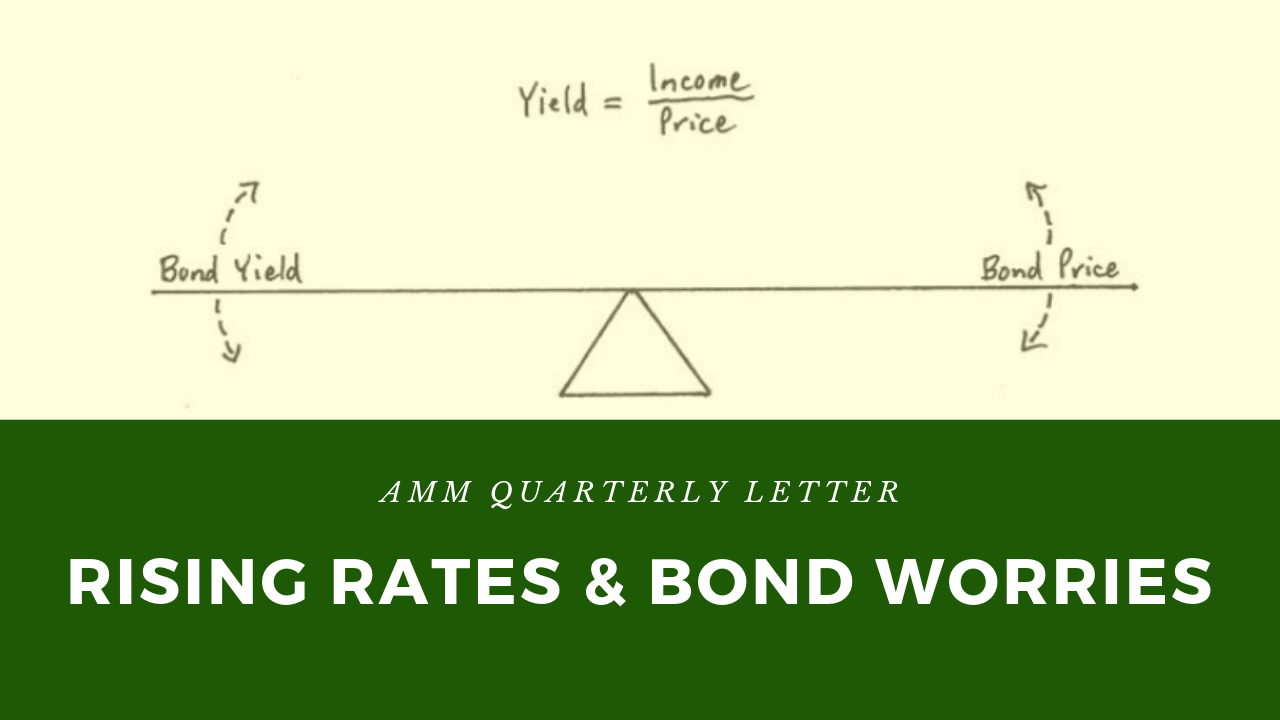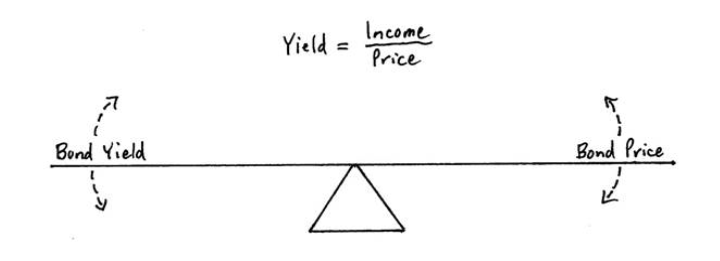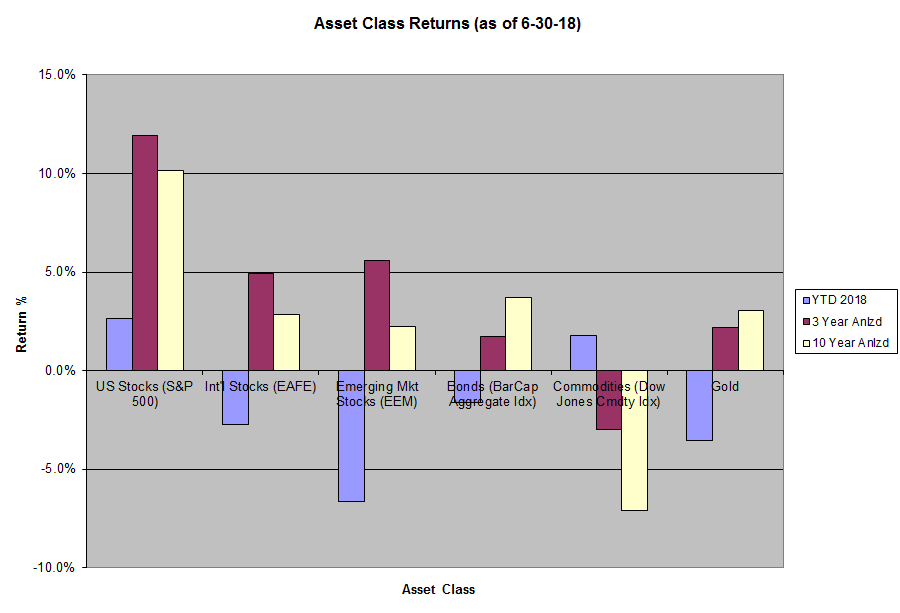AMM Third Quarter Client Letter:
Over the last few years, no topic seems to have garnered as much interest and concern in the financial world than the specter of rising interest rates. For good reason, since interest rates affect everything from the availability of credit to the pricing of every asset on the planet. While higher interest rates mean a higher cost to borrowers, even more importantly, they represent a higher return threshold for investment assets. For example, consider a stock with a dividend yield of 3%. When risk free treasury bonds yield 2.5%, there is a net cash benefit to owning the higher yielding stock. But, if the risk free treasury rate rises to 3.5%, then the stock will be less aractive since an investor can get a better rate without taking stock risk. This is a deep simplification, since the stock still provides appreciation potential and may still be attractive to a certain class of investor. Nevertheless, the direction of interest rates has a significant impact on the pricing of assets with lower rates acting as a tailwind to prices, and higher rates generally acting as a headwind.
Exhibit A

Source: BLS, Fact Set, Federal Reserve, J.P. Morgan Asset Management Real 10-year treasury yields are calculated as the daily Treasury yield less year-over-year core CPI Inflation for that month except for June 2018, where real yields are calculated by subtracting May 2018 year-over-year core inflation.
For years, market pundits, fed watchers and investors have been preparing for the end of the long downward trend in interest rates highlighted in Exhibit A. Perhaps no asset is more sensitive to rising rates than bonds whose prices tend to be inversely correlated to prevailing interest rate movements. Higher interest rates generally mean lower prices for bonds that were issued with lower interest rates (coupons). This occurs because new bond issues become available that pay investors the higher current rates. While a rising rate environment acts as a headwind to bond returns, we do not think that rising rates or fear of rising rates is reason enough to abandon this important asset class from a diversified portfolio. Before diving deeper into our rationale for bonds, we offer the following bond primer.
Bonds 101 – A (Very) Brief Primer
Both governments and corporations issue bonds while only companies issue stock; so, the size of the bond market is significantly larger than the stock market. Currently, the US bond market is estimated to be roughly double the size of the US stock market with a value of more than $40 trillion; the global bond market is estimated to be worth north of $100 trillion. Unlike stocks, bonds do not typically trade on an exchange but on what is called the over the counter (OTC) market. This means that there can be a wide dispersion in pricing on the same bond offered by different dealers. Also, bonds come in all shapes and sizes: corporate, government, municipal, mortgage, low quality, high quality, short‐term, long‐term, convertible, etc. Some have special features like calls, sinking fund provisions, etc. For the purposes of this very basic primer, we will assume a plain vanilla non‐callable corporate bond in examples below.
A share of stock represents ownership in a business. A bond represents a claim on the cash flow of the business but no rights of ownership. In essence, bond holders are lenders to the company while stockholders are owners of the company. As a borrower, the company is contractually obligated to make periodic interest income payments (i.e. coupon payments) to the bond holder. While the bond holder has no voting rights, they typically have seniority over the stock owner in the event of a liquidation. In short, bond holders are primarily seeking a conservative cash return via interest income, while stock holders are typically seeking growth (and sometimes dividend income) from their investment.
Basics: Pricing, Trading and Maturity
Bonds are generally issued with a face value of $1,000. So an investor who buys $10,000 of bonds at issuance will own 10 bonds with a face value of $10,000 (10 x $1,000). After the original issuance (think of this as an IPO for the bond offering), the bond will begin trading on the secondary market where it will trade above or below the $1,000 face value depending upon a variety of factors including changes to the fundamentals and/or credit quality of the underlying issuer and interest rate movements. This is very similar to the day to day movement of stock prices; but, given the seniority of bonds to stocks, bond prices tend to be much less volatile than stocks over time. Unlike stocks, bonds have a stated maturity date at which time the investor will have the face value of their bonds returned to them. Longer term bonds with maturities greater than 10 years tend to be more volatile and sensitive to moves in interest rates. Since there is much more clarity over shorter time frames, a bond with a 1 year maturity will be less volatile than one with 10 years to maturity, all else being equal.
The Price‐Yield Relationship
Perhaps no asset garners greater aention from interest rate watchers than bonds. This makes sense as the price of a bond is directly related to its yield or current interest rate. The yield is calculated by dividing the income/coupon payment by the price of the bond. So a bond that pays a 3.5% coupon will pay $35 for each $1,000 invested at issuance. $35/$1000 = 3.5%. In short, when bond prices rise, the yield declines and vice versa. Importantly, the price‐yield relationship helps to explain why bonds fall when prevailing interest rates rise. If interest rates rise and a new bond (equivalent in credit quality and term) is issued with a 4.5% coupon, then the 3.5% coupon bond will need to fall in price in order to match the new 4.5% yield offered by the equivalent bond.
Why Own Bonds in a Rising Rate Environment?
Too often, investors come to a false conclusion that rising rates always equates to bond losses. While losses do periodically occur in bond portfolios, these are often reduced or mitigated by the coupon income provided by the bond. The equation for total return is as follows: Total Return = Price Change + Income. So the more income generated, the more it will offset a negative price change. Exhibit B shows 4 distinct episodes of rising rates since 1994 and the accompanying returns of three categories of bonds: US Corporate, US Government, and High Yield.
Exhibit B

Sources: Morningstar Direct, Wells Fargo Investment Institute. Data as of April 30, 2018. All returns greater than 12 months are annualized.
Even though bonds may periodically have negative returns, we think that there are several reasons for balanced and income oriented investors to maintain exposure to bonds in a rising rate environment:
- Safety: Corporate bonds are “higher on the capital structure” than stocks. So, there is a greater likelihood that a
bond holder will be paid back something in the event of a company liquidation vs a stockholder. For government
bonds like treasuries, the bonds are backed by the full faith and credit of the US government (i.e. the power to
tax). So, the likelihood of default is near zero. US treasuries were one of the few asset classes that provided positive
returns during the 2008 financial crisis. - Income: The coupon income is generally one of the primary reasons investors buy bonds. They are seeking some
form of cash income. While stocks also provide income via dividends, bond income is generally more reliable and
predictable as it is contractually guaranteed. Companies can raise, reduce or eliminate dividend payouts. - Diversification: In a traditional balanced portfolio, the advantage of owning both bonds and stocks is that they have
relatively low correlation and provide a barbell approach: one goes up while the other goes down. - Maturity Management: Portfolios that ladder maturities over several years will regularly have bonds maturing,
which can then be reinvested into new bonds with higher interest rates. - Uncertainty: As we often say, the future is unknowable. While we may be in a rising rate environment today, this
could change quickly. Bonds relatively low correlation to stocks and other assets may help to provide an important
ballast during the next market storm or recession.
Mid-Year 2018 Review
Through 6/30/18, domestic stocks (S&P 500) were up 2.7%, developed international stocks (EAFE) declined ‐2.8%, and emerging market stocks (EM) declined ‐6.7%. Bonds (Bar Cap AGG Idx) declined ‐1.6%, commodities were up 1.8%, and gold declined ‐3.6%. We have updated our asset class return chart (Exhibit C) to reflect YTD 2018 along with three and ten year annualized returns for the aforementioned asset classes.
Exhibit C
Year‐to‐date, market returns remind us of our oft quoted statement that 80% of a portfolio’s returns come 20% of the time. After a blistering start to the year, domestic stocks gave back all of their returns and then some by the end of the first quarter only to partially rebound by the end of Q2. While domestic stocks have put up modest numbers as of midyear, it is important to note that the leadership in the S&P 500 has narrowed immensely, with 6 stocks accounting for nearly 70% of the S&Ps year‐to‐date return. While the price of the US market in aggregate is far from “value” or “bargain” levels, the earnings picture remains solid, and the domestic economy appears on firm footing. For this reason, we are maintaining our cautiously optimistic stance but have generally maintained slightly below target weights to US stocks due to valuation concerns.
International stocks did not fare nearly as well in the first half of 2018. However, as is usually the case, the poor performing asset looks more aractive from a valuation perspective than the better performing asset. For this reason, we continue to look through the noise of trade concerns, EU politics and emerging market volatility, and are marginally overweight international stocks in diversified asset allocation portfolios.
For bonds, we continue to allocate investor capital with a bias towards a rising rate view. This means a lower than normal exposure to traditional bonds and a higher weighting to alternative fixed income assets including floating rate notes and unconstrained bond funds. Finally, inflation appears to be slowly firming, and we continue to allocate to both gold and commodities as longer term inflation hedges.
Should you have any questions regarding your investment account(s) and personal financial plans, or if there have been any recent changes to your investment and/or retirement objectives, please do not hesitate to contact our office to speak with one of us at your convenience.
As always, we thank you for entrusting AMM to help you achieve your investment and retirement objectives.





